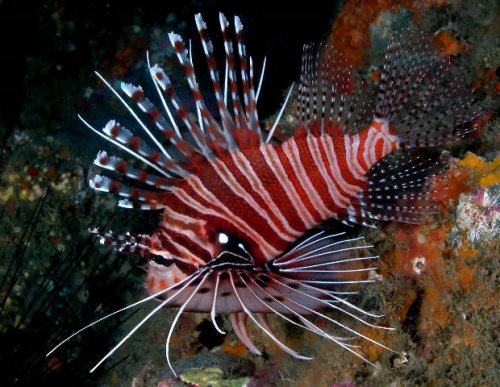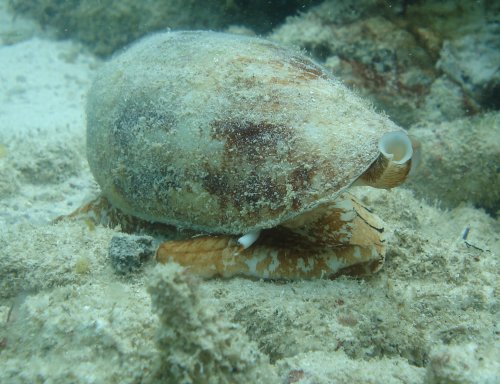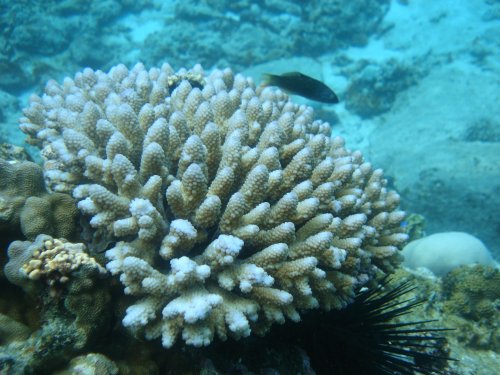Safe Collecting

by Doug Brennan
As this site is "seashell-collector.com", the following information is aimed at "Shellers".
That odd breed of ocean going, salt water swallowing, willing to swim for hours and still come home empty handed, seashell collector.Shell collecting should be a safe and enjoyable experience, but even the most experienced divers can get into trouble. The more you know about what awaits you in the ocean, the better chance you have of making it home in one piece, with your shells. FYI? I am just talking about snorkeling here. You others (SCUBA and Hookah divers) should have already been trained! At times I hear beginning divers voicing concerns about sharks and barracudas, right along with the whale that swallowed Jonah. Those creatures, while due great respect, are usually the least of a reef diver?s worries. The purpose of this post is to hopefully help other divers avoid some of the more common injuries and enjoy the shelling. I can?t possibly warn you of ALL the hazards that a diver might encounter. However, at David?s request I will be happy to answer any questions I am able to. Others are free to join in the discussion. My "credentials"?? Well, I am what would be called a "local" diver. Having learned primarily from the experiences of over 1000 free dives outside reefs and along the cliff lines, mostly spear fishing at night. I speared fished commercially for about 15 years, supplementing my income as an automobile technician, to support my family.
The following information is based on that experience? it is not scientific in anyway, shape or form. First things first, let?s start with coral. Coral (along with clean clear water) is the life?s blood of the reef, home to the shells we seek. Treat it well. Coral is a living animal. It will not chase or attack you. It can, however, cause you a great deal of pain and grief. Hard corals are sharp? very sharp, no matter how soft or smooth they appear. They can turn exposed flesh into raw hamburger in the blink of an eye.

This is a dangerous fish (Pterois antennata)… only if you try to put your hands on…
All it takes is being unfortunate enough to be hit by a wave and pushed into it, rolled over it by a wave or simply putting your foot in the wrong place. Many corals are relatively brittle and the weight of your body may be enough to snap them loose, sending your leg into a hole lined with razor blades. To avoid this, plan your entry and exits carefully. Utilized natural or man-made channels, thereby bypassing a lot of the heavier coral at the reef?s edge. Learn how to spot channels from the outside of the reef in case of an emergency. Look for water that is cloudier than normal, water that seems distorted or "wavy" (an effect created by the mixing of warm inter-tidal water and the cooler ocean water).
While not an animal or stationary object, a quick word about how dangerous the currents in and around channels can be is warranted here. Ocean currents are dangerous! Again, PLAN the dive and know the area! Another coral injury would be from burns? well? it sure feels like a burn! "Flame" or "Fire" corals do exist in various forms. All it takes is the slightest contact with it to produce a burn that will sting, itch and blister. Cuts, scrapes and brushes with coral can also result in infections if parts of the living animal are introduced under the skin. If wounded, clean it up, disinfect it and keep it dry. Next on the list of common injuries would be spiny sea urchins. They are basically black pincushions. Technically they do move. I list them here because they tend to hide around and under coral heads and stay put. Stepping on one, inadvertently grabbing one or being pushed against one by a wave can ruin your whole day (and quite a few more, depending on where you get hit). What ever you do, do not sit on one!!! There is not much you can do about them after you have "encountered" one, but live through the pain. Scrape off any exposed, loose spines. You CANNOT pull them out.

This little guy can hurt you to death… (Conus geographus, Seychelles, 2010)
They are too brittle. Soaking the area in hot water eases the pain a little, but even that doesn?t help much. While infection may occur, the discomfort usually goes away in about 10 days. A painful (and fortunately infrequent) visitor to the reef is the Crown of Thorns starfish. While they look soft enough, solid contact with a Crown feels like getting hit by a train. The pain is instantaneous and intense! You will most likely survive the sting, but are in danger of drowning if you don?t regain your senses quickly. In addition to the initial pain, the skin around the wound will swell, harden and become very red within a few hours. That misery may be accompanied by a fever. You?ll feel better in a few weeks. The other little headache on the Crowns is that the spikes are strangely brittle. The tips may break off and imbed themselves deep under your skin. They will be hard to see with all the swelling and might heal over without you knowing they are even in there. Several months or years later, they can "pop" out, intact.
I have heard some people are allergic to the toxin, so be careful. Infestations of Crown of Thorns do occur. When it does you will see literally thousands of them all over the reef. I have read that this is a naturally occurring phenomenon, which can last for a few years. Having seen it happen, I believe that. While capable of movement, the sedentary Stonefish delivers a powerful punch. Be careful what you touch, when reaching around to grab a rock, or putting your foot down (even when you looked first). Their camouflage is great and the pain is intense!!! The venom is delivered through the fin spines and can go right through a wet suit, tennis shoe or leather glove. At first it feels like a pinprick. Then the pain starts to radiate out. A small, dark purple spot appears at the puncture point(s). The spot(s) will increase in size over a relatively short period of time. The pain seems to increase with the size of the spot, to the point of near insanity.

Avoid touching live corals… for your and their safety… Take care of this black sea urchin too…
An immediate trip to the hospital is in order here. Soak the wound in hot water on the way, if you are able. At the hospital, they will start or continue the hot water soak. You will most likely be given anti-venom and then treated for the pain. Just to give you an idea of what this is like, our 8 year old stepped on one. He was in the Emergency Room within 30 minutes. They gave the poor little guy morphine for the pain. I thought he would be out like a light in seconds. Wrong, he was still screaming bloody murder 45 minutes after the injection. At the one hour mark, they give him Tylenol 3 (Codeine). Half an hour later he was calm enough to take home. Be safe out there !
Following is our standard advice for shellers… particularly beginners. This may be too much information, if so, I apologize in advance. Safety First…
Please print the list out and take it with you. The most dangerous things on a reef don't move a lot (coral, sea urchins, eels in holes, stone fish, etc.). Just being aware that those things do exist and watching out for them will save you a lot of grief (and pain). Also, remember that cone shaped shells are poisonous and must be handled with extreme care… do not put them in a cloth sac that might rest against your body. The harpoon-like stinger can reach almost 3/4 the length of their body, so always handle them by the large end, never the pointed end. Several species of cone shells can kill you. I would suggest you snorkel inside the reefs only, if you are a beginner. If you plan on seeing live seashells during your dive(s), then look for fairly shallow areas with lots of loose rocks. Wear a pair of gloves and thick-soled reef walkers (shoes). When diving during the day, carefully (remember the sea urchins and stonefish) turn the loose rocks over, even the small ones. This is where you will see shells from the cypraea family. When you first see a shell, it might look like a slug, as the animal has a tendency to cover the entire shell. A light touch is usually enough to cause the animal to retract and expose the shell. You may have to turn over several hundred rocks to find a few shells. If there is sand under the rock, dig lightly, you may uncover a cone, mitra or other sand dwelling shell.
Be sure to turn the rock back over (to its original position) when you are finished. Plants and animals that the shells feed on live under the rocks and will die if left exposed. Just because there is no shell under that particular rock today, doesn?t mean there won?t be one there later? as long as the food source stays intact. Also look into holes in the rocks and under metal debris, as they love to hide in the weirdest places. If the reefs in your area are like the ones here on Saipan, I wouldn't stick my hand into any large holes to feel around (see reef hazards).
Occasionally, you will find a shell sitting on top of what appears to be small, colored grains of rice. Those are egg clusters, that shell should not be disturbed. Each "rice like grain" in the cluster contains hundreds of eggs. If the tending shell is removed, the eggs will fall prey to other reef creatures in a short period of time and then nobody will find shells. Another tip? DO NOT pick up every shell you see! Examine each shell carefully under the water. Under water they will look much larger than they really are, carry a small plastic ruler with you to be sure of a shell?s size.
If the shell is damaged (has an obvious flaw, crack, healed wound, etc.) or is not fully adult, carefully put it back under the rock or sand. Shells with obvious flaws have little or no value to a collector, but are still capable of reproducing and should be left to do so. As for the time of day or the position of the tide, this is a toss up for me. My wife, kids (ages 13, 12 and 9) and I shell regularly, we prefer a "comfortable depth".
Some areas are too shallow to swim in at low tide. We prefer to snorkel for shells as opposed to "reef walking", less chance of damaging the coral and ourselves. Use common sense and know the average depth of the area you plan on searching, with or without the tide, we prefer 2 to 4 feet of water. Diving on a moonless night will give you a better chance of finding more unusual shells, as they will exit their holes in search of food. Again, look in and around small holes in the coral… especially on the roof of the openings. If the bottom is sandy, look for trails in the sand.
Follow the trails to the end and dig lightly, many cones, mitra and olive shells are found this way. Be careful around the mouths of channels, large and small, as the currents can be treacherous. While in the water, listen and watch for boat traffic. Be safe out there, dive with a partner or two, take along a disposable under water camera (usually about $20 for 2 dozen photos) and have the time of your life.
Once you have found the live shells… how do you clean them? Try this method if you have the time… take a small glass container with a lid that seals tightly (an old wide mouthed jelly jar works great). Fill the jar with enough vegetable oil (the cheapest you can find at the grocery store) to cover the shells (don't put them in yet). Mix in baking soda (not powder, soda).
The ratio should be about 4 parts oil to 1 part soda by volume. The soda will NOT dissolve, but will suspend itself in the oil for awhile. Carefully put the shells into the mixture and cover it tightly. Let the shells soak in the mixture for at least a week. The soda will settle to the bottom and hopefully cover the shells. DO NOT open the jar indoors! Your spouse will throw you out of the house… it will really stink.
The oil will kill and allow the animal to rot. The soda will neutralize the acid from the rotting animal and keep the surface of the shell bright and fresh. After a week or so, open the jar outdoors. If the shell has an operculum, remove and save that, then take a garden hose and blow the remaining animal out using a high-pressure nozzle. At times, some of the larger pieces of the animal will get stuck in the aperture.
A thin piece of wire with a small hook bent into the end will help in pulling those bits out. After the animal is out (you will be able to tell by smelling the shell), many can simply be dried off and added to your collection (like cypraea). Some shells (like cones and conchs) will have a periostracum or coral encrustation on them.
They can be cleaned further by a second soak, only this time in a mixture of bleach and water (a 50-50 ratio works well). Soak the shell overnight, rinse it off with fresh water and allow it to dry. The periostracum should be gone and any left over encrustation should be fairly easy to remove by carefully picking at it with a sharp, pointed tool.
Hope this is helpful, Good Shelling !